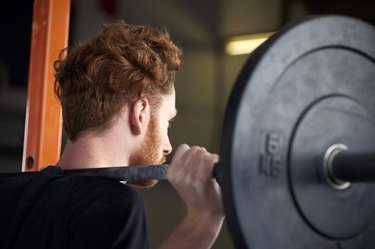
The shoulder press reigns supreme when it comes to training the anterior deltoids, or fronts of the shoulders. However, this simple exercise isn't so simple when you start to examine it. Proper form can make or break the effectiveness of the move.
Pressing in front of the face is often the way it's prescribed, with the intention of preventing shoulder injury. However, pressing from behind the neck can be just as effective and safe for much of the population.
Video of the Day
Video of the Day
Both are Effective
The difference between the front press and the behind-the-neck press doesn't require a lot of technical explanation. Hold a barbell with your hands about shoulder-distance apart, arms extended overhead. Bend your elbows to bring the bar in front of your face for front presses or bring the bar behind your head for behind-the-neck presses.
A study published in the Journal of Sport and Health Science in 2015 showed that both variations are effective and safe in training the shoulders.
Stay Healthy
For behind-the-neck presses to be safe, you need good back health and core strength, as well as optimal shoulder mobility.
Women, in particular, are vulnerable to kyphosis, or the dreaded hunchback, while doing behind-the-neck presses when their torso is weak, showed the 2015 study.
Behind-the-neck presses when done by men or women with inadequate shoulder and upper back mobility can lead to shoulder joint injury. A 2000 issue of the Physician and Sportsmedicine documented a case of a young lifter who dislocated both shoulders while doing behind-the-neck presses. The researchers suggested beginning lifters or people with known limitations in the shoulder joint opt for front presses.
Get Your Body Ready
For behind-the-neck pressing, strengthen your core, particularly the paraspinals and transverse abdominis, with stabilization exercises such as plank holds, paloff presses and bird dogs.
Shoulder mobility is critical to safe behind-the-neck pressing. For a successful and safe behind-the-neck press, you must be able to raise your arms up by your ears and keep your ribs from popping forward, without pain or extreme discomfort. If you excessively shrug, push your chest forward or can't get your arms up past your face or temples, it's an indication that behind-the-neck presses may not be for you, yet.
To improve shoulder mobility, do the following:
Wall Extensions: Stand against a wall so that your back and heels touch the blank surface. Bend your elbows to 90 degrees and place the backs of your palms against the wall, elbows at shoulder height. Keep your arms against the wall as you extend your elbows and reach the arms up. Return to the starting position to complete one repetition; do 10 to 15 reps three to four times per week.
Down Dog on the Wall: Stand facing a wall and step back far enough that you can hinge forward from your hips and place your hands against the flat surface, shoulder-width apart. Push into the wall and relax your chest and the fronts of your shoulders to drop inside your biceps. Hold for 2 to 3 minutes. Perform daily or as often as you like.
Chest Expansion Fold: Stand with your feet hip distance apart, or slightly wider. Clasp your hands together behind your tailbone, using a towel or yoga strap to bridge the gap if your hands don't meet. Push your feet into the floor and hinge forward from your hips. Allow your hands, still clasped, to pull gently away from your back as much as possible. Hold for eight to 10 counts and rise back up. Do this exercise daily or several times per day.
Read More: Exercises for Increased Shoulder Flexibility

Other Precautions
Front pressing is a safer option for beginners who haven't yet developed the shoulder strength and mobility required for behind-the-neck pressing. Also, anyone rehabbing from shoulder injury should avoid behind-the-neck presses due to the potential for compromise to the joint. Women may also find the behind-the-neck option causes back pain overtime and prefer a front press.
While you may be able to clean a barbell from the floor for front presses, entry into the back-of-the neck press is best done with a barbell rack set to shoulder height. Stand with your back to the bar and grasp it with an overhand grip to unrack and press up overhead.
Read More: Shoulder Press Exercises